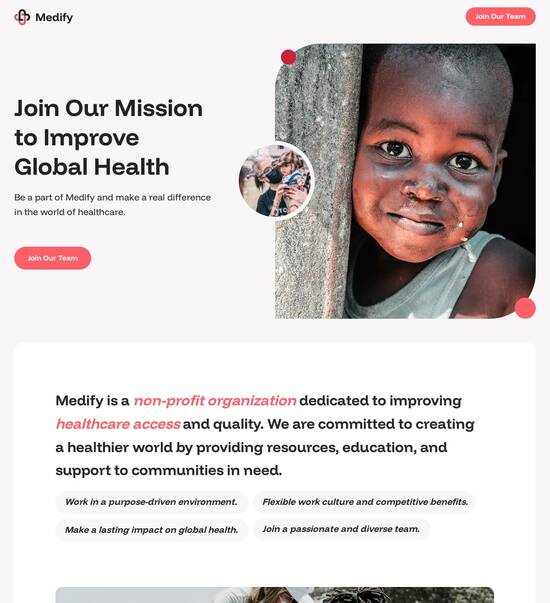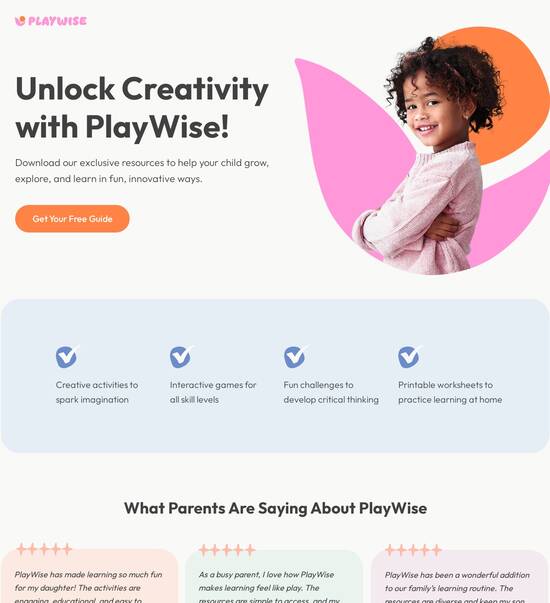
PHP optimized GDPR compliance page template
Explore Similar TemplatesAbout template
Supercharge your GDPR compliance page with PHP for outstanding performance! Learn more today.
Recommended templates

Easy to build without coding
With the intuitive drag-and-drop builder, anyone on your team can create high-converting pages without any knowledge of code or design. Make enhancements to your landing page with custom widgets using Javascript, HTML/CSS, or third-party scripts.

Multiple layouts for any industry and goal
Select from 500+ landing page layouts built to boost conversions across industry-specific scenarios. Customize them by adjusting fonts, adding images, and generating on-brand content with the AI assistant. Quickly scale with Instablocks® and Global Blocks that you can save, reuse, and update globally.

Loads fast and looks polished on any device
Every template is responsive, which means they present professionally on any device and load blazingly fast with our Thor Render Engine. You can also power them up with Google AMP technology to deliver an unparalleled mobile experience and drive higher conversions.

Robust analytics & experimentation
Get real-time updates and reporting across all your devices, showing the number of visitors, conversions, cost-per-visitor, and cost-per-lead. Launch AI-powered experiments, run A/B tests, and use heatmaps to analyze user behavior, then optimize your landing page to maximize conversions.







Easy to build without coding
With the intuitive drag-and-drop builder, anyone on your team can create high-converting pages without any knowledge of code or design. Make enhancements to your landing page with custom widgets using Javascript, HTML/CSS, or third-party scripts.
Multiple layouts for any industry and goal
Select from 500+ landing page layouts built to boost conversions across industry-specific scenarios. Customize them by adjusting fonts, adding images, and generating on-brand content with the AI assistant. Quickly scale with Instablocks® and Global Blocks that you can save, reuse, and update globally.
Loads fast and looks polished on any device
Every template is responsive, which means they present professionally on any device and load blazingly fast with our Thor Render Engine.
Robust analytics & experimentation
Get real-time updates and reporting across all your devices, showing the number of visitors, conversions, cost-per-visitor, and cost-per-lead. Launch AI-powered experiments, run A/B tests, and use heatmaps to analyze user behavior, then optimize your landing page to maximize conversions.
All the features you need to build lead-generating landing pages
Explore more featuresLearn how to build top-performing landing pages for any goal
FAQs
Leading the way in building high-performing landing pages





A comprehensive guide to creating effective landing pages with Instapage
Leveraging Instapage allows marketers to construct tailored landing pages that enhance lead generation and maximize ROI across various sectors including financial services, education, and tech. This guide walks you through a systematic approach to utilizing Instapage’s robust features to ensure your digital campaigns yield optimal results.
Understanding the importance of optimized landing pages
Optimized landing pages play a crucial role in digital marketing by ensuring visitors have a seamless experience from ad to conversion. They are designed to capture leads and close sales effectively. The ability to customize and personalize these pages is vital for success in different marketing verticals, including marketing and advertising and government.
- High-converting templates save time and streamline the process.
- Personalization boosts engagement by delivering tailored content.
- A/B testing helps refine strategies based on data-driven insights.
Step 1: Leveraging Instapage's powerful templates
Begin your journey by exploring the extensive library of over 100 pre-built templates. These templates are crafted to capture leads effectively. Choose one that aligns with your marketing strategy and customize it to fit your messaging and branding.
- Select a template based on your campaign goals.
- Make use of drag-and-drop functionality to enhance layout.
- Incorporate lead generation elements right from the start.
Step 2: Personalize for your specific audience
Personalization is key; make use of dynamic text replacement to match your audiences' expectations. This approach increases conversion rates by ensuring your content resonates with visitors' needs during their decision-making journey.
- Utilize AdMaps to align ads with relevant landing pages.
- Monitor audience metrics to refine targeting.
- Deliver tailored messages to specific segments of your market.
Step 3: Optimize and analyze for continual improvement
Utilize Instapage's built-in tools for optimization. Analyze heat maps to see where users engage most and conduct A/B tests to compare different versions of your landing pages. Regularly assess analytics to understand performance metrics and adjust your strategy accordingly.
Each of these steps fosters a cycle of improvement that can significantly enhance your marketing efforts, ensuring you consistently achieve better outcomes.
Ready to take your landing pages to the next level? Start utilizing Instapage today and transform your digital marketing campaigns into powerful tools for lead generation.
People also ask about PHP optimized GDPR compliance page template
PHP optimized GDPR compliance page template
The importance of GDPR compliance in modern web development
The General Data Protection Regulation (GDPR) has become a cornerstone in global data protection legislation. For organizations, understanding GDPR is essential to not only comply with legal requirements but also to foster trust with customers. By being transparent about data collection and processing, businesses can establish a strong rapport with their audience.
The key principles of GDPR, which include data minimization, purpose limitation, and storage limitation, demand that organizations take accountability for the data they handle. This puts significant emphasis on how businesses interact with their data subjects and obligates them to protect personal information proactively.
Data minimization: Only collect the information that is absolutely necessary.
Purpose limitation: Clearly define the purpose for data collection.
Storage limitation: Don't keep data longer than required.
The significance of data protection cannot be overstated, as consumers are increasingly aware of their rights regarding personal data. GDPR not only gives them more control but also educates them about the value of their information. When organizations prioritize compliance, they can enhance their reputation and avoid potential pitfalls.
The risks of non-compliance
Failing to comply with GDPR regulations can lead to serious legal repercussions for organizations. Penalties can soar up to €20 million or 4% of a company's global annual turnover, whichever is higher. This financial burden signifies that compliance is not merely an optional consideration but an essential practice.
Moreover, non-compliance can severely impact customer trust and brand reputation. In a world where consumers are becoming increasingly selective about the businesses they engage with, losing customer trust could result in significant revenue losses and long-term damage to brand loyalty.
Navigating the landscape of GDPR regulations
To effectively navigate the landscape of GDPR regulations, organizations must understand essential requirements that are vital for web applications. Firstly, data subject rights are paramount; they include rights to access, correct, and even erase their data from systems. Organizations need to implement systems that enable users to exercise these rights seamlessly.
Transparency is another core requirement; data processing practices must be clear and readily understandable for users. Providing detailed privacy notices and clear terms of service can go a long way in educating consumers about how their data is handled.
Right to access: Users should know what data you hold about them.
Right to rectification: Allow users to correct inaccurate data.
Right to erasure: Users must have the option to delete their data.
The role of data processing agreements (DPAs)
Data Processing Agreements (DPAs) are crucial in maintaining GDPR compliance. They serve as a legal framework between data controllers and processors to define the responsibilities and obligations pertaining to data handling. This clarity can prevent misunderstandings and liability issues for all parties involved.
Best practices for creating effective DPAs include clearly outlining the scope of data processing, emphasizing confidentiality obligations, and detailing data security measures. Regularly reviewing these agreements is also wise to ensure that they remain compliant with the latest regulations.
Leveraging PHP for GDPR compliance
Using PHP for GDPR compliance is an excellent choice as it offers scalability and flexibility that many other languages may not provide. PHP is widely practical for web applications due to its user-friendly nature and robust community support. Its capability to integrate databases, session management, and user authentication makes it ideal for building secure applications that handle personal data efficiently.
Moreover, PHP has various libraries and frameworks designed specifically to enhance data protection and facilitate GDPR compliance. Popular frameworks like Laravel and Symfony come equipped with built-in features for data validation, protection against SQL injections, and user authentication methods.
PHP libraries such as GDPR-compliant tools can assist in data anonymization.
Utilize frameworks with built-in security measures for user data handling.
Regularly apply security patches and updates to mitigate vulnerabilities.
Building a GDPR-optimized compliance page template
A GDPR-optimized compliance page is essential for informing users about their rights and how their personal data is used. There are several structural components integral to an effective compliance page. Firstly, a clear and concise privacy notice is a must, explaining what information is collected and for what purpose.
Secondly, user consent mechanisms should be implemented to ensure that users are making informed decisions. This involves checks for consent for cookies, data processing, and marketing communications. A detailed description of data processing activities should also be included, outlining how data is collected, processed, and stored.
Clear and concise privacy notice outlining data collection practices.
User consent mechanisms for data collection and processing.
Detailed descriptions of data processing activities accessible to users.
Access and rectification rights for citizens should be easily defined.
Integrating PHP for dynamic content management
Using PHP web APIs can greatly enhance dynamic content management on compliance pages. This allows organizations to capture and manage user preferences seamlessly, ensuring that the compliance page is always up-to-date with the latest legal requirements. For instance, developers can create user dashboards where individuals can adjust their consent settings.
Real-time updates for compliance regulations are also essential. By leveraging PHP's capability to interface with databases and APIs, organizations can automatically fetch the latest regulatory changes and update their compliance statements without manual intervention.
User-centric design for compliance pages
Creating engaging compliance pages requires a user-centric approach. Language clarity and accessibility are crucial; users should not feel overwhelmed by legal jargon. Compliance documentation should use straightforward language to impart essential information, facilitating better understanding and engagement.
Utilizing intuitive formats and layouts can make a compliance page more appealing. Incorporating visuals, bullet points, and highlight boxes can guide users through the content effectively. Ensuring mobile responsiveness and cross-browser compatibility are vital for reaching all users, regardless of their device or browser choice.
Use clear language and avoid complex legal terms.
Incorporate visual elements like bullet points and highlight boxes.
Ensure compliance pages are mobile responsive and compatible across multiple browsers.
Enhancing security features in compliance template
Enhancing security features in compliance templates should prioritize HTTPS and data encryption. Secure transmission of data is of utmost importance; not using HTTPS can leave data susceptible to breaches. Implementing SSL certificates is a straightforward strategy that significantly bolsters data transmission security.
Regular security audits and maintenance are essential to uphold the integrity of the compliance page. Keeping security patches up-to-date, monitoring vulnerabilities, and employing tools to assess risks in web applications contribute to long-term compliance and security.
Utilize HTTPS and SSL certificates for secure data transmission.
Conduct regular security audits to identify vulnerabilities.
Implement monitoring tools to assess risks continuously.
Customization and scalability of PHP compliance solutions
Tailoring compliance templates to fit organizational needs is a significant advantage of using PHP. Modifiable components can cater to industry-specific standards, allowing businesses to comply effectively based on their operational requirements. Custom implementations serve to meet the specific demands of various sectors, ensuring that the compliance framework is relevant.
As organizations grow, scaling compliance strategies become equally necessary. PHP's flexibility makes it feasible to adapt to new data processing regulations, enabling businesses to respond proactively to legislative changes.
Adapt compliance templates based on industry standards.
Implement successful custom solutions tailored to specific needs.
Integrate ongoing training for employees regarding data protection.
Collaborating with PHP experts for compliance
Finding and engaging qualified PHP developers can be a game-changer in achieving GDPR compliance. Key skills to look for include experience with data handling frameworks and a thorough understanding of privacy regulations. Collaborating with skilled professionals can provide organizations with the knowledge necessary to maintain compliance.
The role of instructors and training programs also plays a crucial part in compliance efforts. Implementing training for staff on GDPR best practices equips organizations with the capabilities to manage data responsibly, fostering a culture of compliance.
Evaluating the impact of compliance on organizations
Having a GDPR-compliant web presence comes with significant benefits, including enhanced consumer trust and loyalty. Companies that are transparent about data handling are likely to cultivate stronger relationships with their customers, resulting in elevated brand loyalty.
Measuring compliance efficiency and effectiveness is equally crucial. Organizations should establish clear metrics to evaluate the impact of their compliance efforts, including customer feedback and audit results, which help continuous improvement processes for sustained compliance.
Improved consumer trust leads to long-term customer loyalty.
Clear metrics to assess the impact of compliance efforts.
Implement continuous improvement processes for compliance.
Future-proofing compliance strategies
Preparing for the evolution in data privacy laws is essential for organizations aiming for enduring compliance. Emerging trends in data protection regulations indicate a shift towards even stricter requirements. Proactive measures organizations can take include regular policy reviews and staying informed on upcoming changes in legislation.
The role of technology in streamlining compliance efforts cannot be overlooked. Leveraging automation and AI tools can simplify the process of compliance monitoring and management. The continued development of PHP frameworks and compliance tools will certainly enhance organizations' capabilities to ensure data protection.
Stay updated on emerging trends in data protection regulations.
Utilize automation and AI for effective compliance management.
Invest in the latest PHP frameworks and tools for compliance.
Ready to skyrocket conversions?
Supercharge your ad campaigns with high-performing landing pages
Get started














